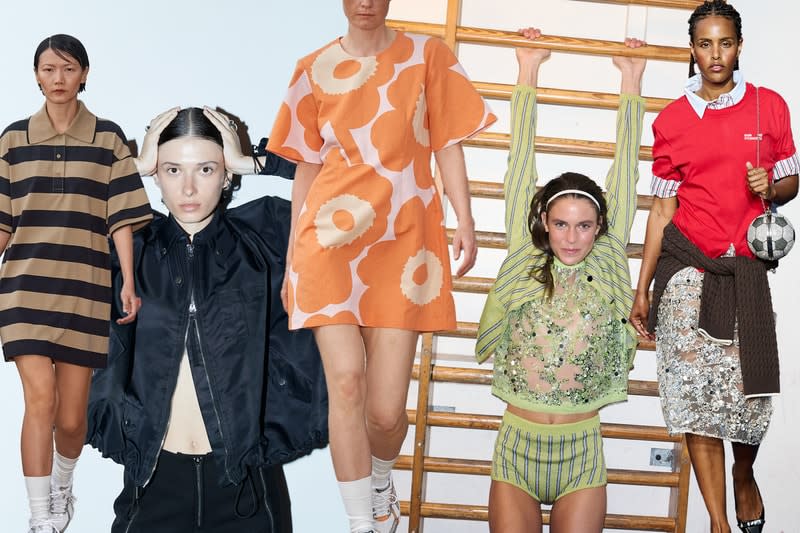Scandinavian style codes are inimitable, instantly recognized due to their minimalist yet expressive nature. Defined by daring prints, crisp linens, and color blocking, 's fashion tendencies have been widely embraced by the internet and fashion girlies worldwide. Aside from putting unexpected combos and high-spirited color palettes on the map, the Copenhagen fashion scene has also raised a higher awareness of sustainability practices within the industry.
In 2020, introduced a that all participating brands must abide by — these standards were then later updated in March 2024 — and include maintaining a formally approved sustainability strategy, circular design principles, and collections crafted from at least 60 percent of certified or deadstock fabric, alongside other social standards and actions which reduce single-use props and packaging. "I feel relieved that our fashion week represents the beauty of the industry and supports emerging brands. Even as a small or medium-sized enterprise, you have to think about these things because you have the ability to inspire those huge players and brands out there.

We're not perfect, but we are trying to foster a healthier relationship with fashion," said CPHFW CEO, Cecilie Thorsmark. Hypebae took to the streets and runways during CPHFW to take in the sights of the season — this edition brought billowing skirts, dynamic patterns, and adaptable, grungy streetwear, along with some forward-thinking sustainable elements that have the potential to truly change the game. runway show transported guests to a rock show proving that indie sleaze is here to stay.
But what may have been even more eye-catching than the brand’s ability to transform its discernibly cool aesthetic into everyday, wearable elements was its use of consciously sourced materials. The brand’s creative minds, Carl Ollson and Felix von Bahder, consistently bring new life to otherwise overlooked materials — conjuring new out of the old. Upcycled leather and discarded textiles graced the runway this season in the form of moto jackets and nostalgic tees, pushing forth an inventive mindset when it comes to textile use.
View this post on Instagram While over at Copenhagen's Øperaparken, brought a whimsical color explosion to the runway (as always). The SS25 collection, The Anatomy of Flowers, reinterpreted the signature flower prints the brand is known for, showing an abstract or more conceptual approach to florals. A new silhouette, chic polo dresses, showed the brand's sporty side as well.
Though new elements emerged, Marimekko stayed true to its eco-conscious roots, as many garments were crafted from certified organic cotton and leftover fabric was converted into cute scrunchies and key chain ribbons. took "office-siren" to new heights, displaying a collection of corporate-core-inspired pieces that blended everyday, functional silhouettes with athletic elements — including pinstripes, numbered jerseys, and sporty sets. While the range's practical yet undeniably chic qualities may have initially caught onlookers' attention, the collection's environmental considerations cemented the looks as more than meets the eye.
Over 50 percent of the fibers in the featured materials came from recycled, organic, or environmentally certified origins, demonstrating that a piece can still possess that "cool factor" without compromising environmental consciousness. View this post on Instagram With CPHFW's Sustainability Requirements in place, all other runway shows and presentations were aligned with this same forward thinking. Meanwhile, over at Copenhagen International Fashion Fair, Scandinavian brands as well as international names came together to show off their latest offerings, many of which included innovative aspects.
The material innovation — probably one of the most prevalent considerations present during CIFF and CPHFW SS25 — continued with other brands present at the fashion fair, including , a Berlin-based luxury ready-to-wear brand that incorporated next-gen post-consumer materials in its most recent collection, from recycled nylon to responsible certified wool. , a Danish activewear brand that makes athleisure actually feel cute, also pushed the boundaries of materiality. The brand showed off workout sets, sports bras, and more crafted from wood based fabrics: TENCELTM Lyocell and LENZINGTM ECOVEROTM.
Danish knitwear brand presented some handknit, one-of-a-kind pieces using discarded yarn from other garments as well. View this post on Instagram Diving into some of these boundary-pushing elements present at Copenhagen Fashion Week grants the wider industry an optimistic look into the future — a future where fashion and environmental regard can coexist harmoniously. Looking ahead to other international seasons to come, there is hope that these advancements will radiate far beyond the Scandinavian region.
.



















